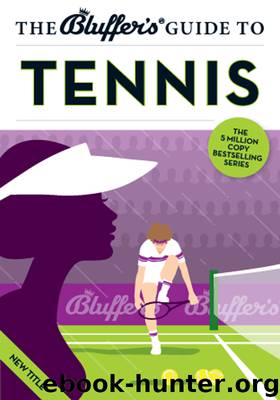The Bluffer's Guide to Tennis by Dave Whitehead

Author:Dave Whitehead
Language: eng
Format: epub
Publisher: Bluffer's Guides
Grunting, shrieking, swearing, screaming, racquet throwing, and abusing the official are all additional ways of putting an opponent off in a pro match.
AMATEUR GAMESMANSHIP
Of course, the vast majority of tennis matches are between amateur players who don’t get to rely on official enforcers monitoring their transgressions. By necessity, they play matches according to the ‘honour’ system. The players make their own rules about drink breaks, cramp relief, knee strapping, blister wrapping, religious observance, and line calls. The inevitable disputes regarding the latter are generally brought to a satisfactory conclusion for both players by negotiation. Not infrequently, this negotiation involves a convincing headbutt.
Gamesmanship resembles an infomercial. It is disturbingly common and designed to separate you from your senses. When playing an expert gamesmanshipper, the desire to win stems from knowing that, should you lose, your nemesis is going to perform a celebratory dance so elaborate that it might well find itself a worthy contender for the All-time-10-most-watched list on YouTube.
There are degrees of gamesmanship. It can be as subtle as a baby’s breath, or as obvious as a neon sign flashing ‘unsportsmanlike behaviour’.
To gamesmanshippers, playing the ‘game’ can be more rewarding than playing tennis. To them, the ability to totally distract you with underhand ploys and schemes to the point where you leap over the net with your racquet raised in a fit of bloodthirsty rage, ready to accept a forfeit and certain jail time, is vitally important. They like to win that way. In fact, they prefer to win that way, because they’re essentially sociopaths.
Some common forms of amateur gamesmanship include:
1. slowing the match down to the speed of coastal erosion by adopting tactics such as replacing shoelaces on an opponent’s game or set point;
2. trying to speed up the match via quick serves (serving when an opponent is retrieving balls, nose-blowing, adjusting a contact lens, etc.);
3. giving the balls back to the server by making them take long trips back to the fence or with point-blank overheads;
4. questioning an opponent’s line calls during the warm-up;
5. offering wholly insincere sentiments of sympathy when an opponent makes a mistake (e.g., ‘Hard Cheese!’ as exemplified by the actor Terry-Thomas in the definitive tennis gamesmanship scene from the film School for Scoundrels); or
6. displaying a rifle stock from a tennis bag.
Always claim to empathise with those who decry the practice of gamesmanship. It is an insidious virus that threatens the very foundations of the game, you will say as you simultaneously try to figure out where their vulnerability lies. If, for example, you hear: ‘If there’s one thing I can’t stand, it’s a six-bounce server’, then you know what you have to do.
MAKING EXCUSES
Since at any given time, 50% of players lose their matches, players are prone to assigning blame for their losses in order to save face with their peers. To establish ‘blame’ as a respectable ‘cause’ and not an ‘excuse’, you must explain that there were ‘extenuating circumstances’.
Tennis is fraught with extenuating circumstances. People lose for a number of reasons (which are nearly always in the mind):
1.
Download
This site does not store any files on its server. We only index and link to content provided by other sites. Please contact the content providers to delete copyright contents if any and email us, we'll remove relevant links or contents immediately.
Unstoppable by Maria Sharapova(3484)
Unstoppable: My Life So Far by Maria Sharapova(2452)
String Theory by David Foster Wallace(1414)
Open: An Autobiography by Andre Agassi(1316)
Zona by Geoff Dyer(1310)
Table Tennis Tactics for Thinkers by Larry Hodges(1271)
You Cannot Be Serious by John McEnroe(1264)
The Pub by Pete Brown(1258)
Rafa by Rafael Nadal & John Carlin(1195)
On Tennis by David Foster Wallace(1180)
Game On by Monica Seles(1174)
Roger Federer by Chris Bowers(1168)
Getting a Grip by Monica Seles(1160)
Table Tennis Tips by Hodges Larry(1097)
Everything You Know Is Pong by Roger Bennett(1096)
Play Better Tennis in Two Hours by Oscar Wegner & Steven Ferry(1095)
Ways of Grace by James Blake(1069)
Days of Grace by Arthur Ashe(1062)
Rod Laver by Rod Laver(1023)
